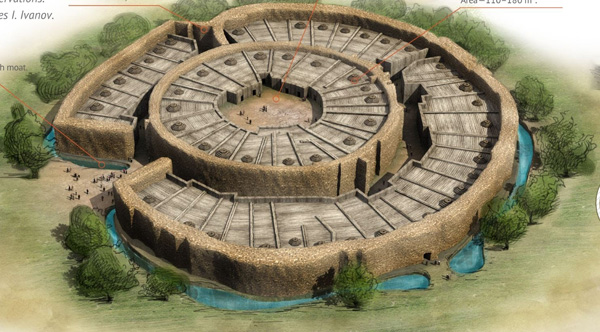
There are hundreds or even thousands of ancient historical sites of interest. Arkaim caught my eye because of the interesting shape and history. The defensible design is perfect for rural sustainable communities that foresee difficult times ahead.
“Arkaim is an archaeological site situated in the Southern Urals steppe just to the north from the Kazakhstan border. The site is generally dated to the 17th century BC. Earlier dates, up to the 20th century BC, have been proposed. It was a settlement of the Sintashta culture.
The site was discovered in 1987 by a team of Chelyabinsk scientists who were preparing the area to be flooded in order to create a reservoir.
The site was protected by two circular walls. There was a central square, surrounded by two circles of dwellings separated by a street. The settlement covered ca. 20,000 m2 (220,000 sq ft). The diameter of the enclosing wall was 160 m (520 ft). It was built from earth packed into timber frames, and reinforced with unburned clay brick, with a thickness of 4–5 m (13–16 ft). and a height of 5.5 m (18 ft). The settlement was surrounded with a 2 m (6 ft 7 in)-deep moat.
There are four entrances into the settlement through the outer and inner wall with the main entrance to the west. The dwellings were between 110–180 m2 (1,200–1,900 sq ft) in area. The outer ring of dwellings number 39 or 40, with entrances to a circular street in the middle of the settlement. The inner ring of dwellings number 27, arranged along the inner wall, with doors to the central square of 25 by 27 m (82 by 89 ft). The central street was drained by a covered channel. Zdanovich estimates that approximately 1,500 to 2,500 people could have lived in the settlement.
Surrounding Arkaim’s walls, were arable fields, 130–140 m by 45 m (430–460 ft by 150 ft), irrigated by a system of canals and ditches. Remains of millet and barley seeds were found.
Wiki
As is often the case with archaeological sites, Arkaim is cloaked in mysteries such as a giant skeleton with an elongated skull. Some say Arkaim was built with greater precision than Stonehenge. “Stonehenge allowed for observation of 15 astronomical phenomena using 22 elements, whereas the contemporaneous observatory at Arkaim allowed for observation of 18 astronomical phenomena using 30 elements.”

Not a lot of light on the interiors.
A wonderful protected community!